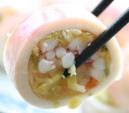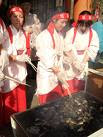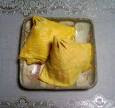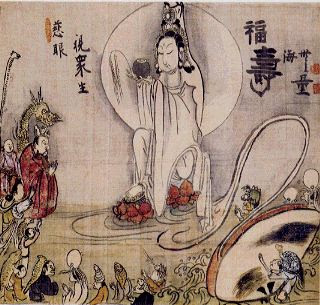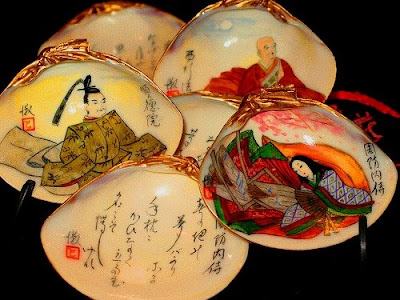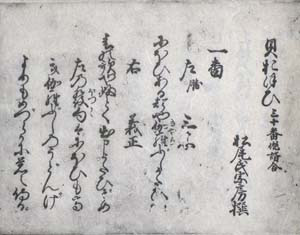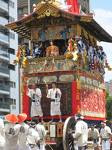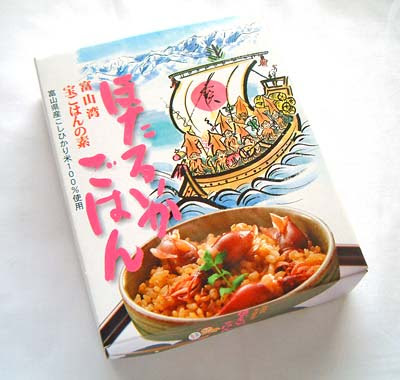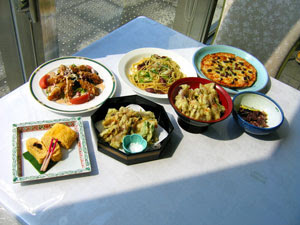::::::::::::::::::::::::::::::::::::::::::::::::::::::::::::::::::::::::::::::::::::::::::::::::::::
Crab meat (kani)
***** Location: Japan
***** Season: Various
***** Category: Humanity
*****************************
Explanation

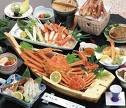
CHECK here for the KIGO related to the animals
WASHOKU : FISH and SEAFOOD SAIJIKI
CHECK here for regional dishes :
WASHOKU : Regional Japanese Dishes
:::::::::::::::::::::::::::::::::::::::::::::::::::::::::::::::::::::::::::::::::::::::::::::::::::::
There are many types of crabs eaten in Japan.
akategani ... あかてがに "Rotarmige Krabbe". Chiromantes haematocheir
benizuwaigani ... べにずわいがに rote Schneekrabbe. Chionoecetes japonicus
often used for canned meat
. . . CLICK here for Photos !
hanasakigani 花咲蟹 "cherry blossom crab"
spiny king crab
. . . CLICK here for Photos !
iwagani, mokuzugani 藻屑蟹 / モクズガニ ... Eriocheir japonicus
Japanese mitten crab
. . . CLICK here for Photos !
In Okayama prefecture, they are called "zugani" ズガニ.
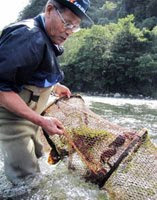 In Autumn, when they start going downriver to lay eggs, they are caught and eaten as a great delicacy. This is also the season when the colorful leaves of the persimmon trees start falling, so they are also called "ki no ha gani" (kinohagani 木の葉蟹). They are caught in the shallows of the river with a woven bamboo trap called "doojiri (どうじり), which can be as long as 5 meters. The crabs have a kind of green back and big scissors.
In Autumn, when they start going downriver to lay eggs, they are caught and eaten as a great delicacy. This is also the season when the colorful leaves of the persimmon trees start falling, so they are also called "ki no ha gani" (kinohagani 木の葉蟹). They are caught in the shallows of the river with a woven bamboo trap called "doojiri (どうじり), which can be as long as 5 meters. The crabs have a kind of green back and big scissors.They are boiled and tofu is boiled with them, to give it extra flavor. They are also cooked with rice. The kanimiso paste is a expecially well loved.
kani ... 蟹 crab. Krabbe, Krebs. Fam. Brachyura
. . . CLICK here for Photos !
kawakani, sawagani ... 川蟹 river crab. Flußkrabbe, Flusskrabbe. Geothelphusa dehaani.
. . . CLICK here for Photos !
kegani ... 毛蟹 hairy crab. haarige Krabbe. Erimacrus isenbeckii.
Best when boiled.
. . . CLICK here for Photos !
kumogani ... 蜘蛛蟹 Schneekrabbe. „Spinnenkrabbe". Chionoecetes opilio
with very long legs
. . . CLICK here for Photos !
kurigani ... くりがに „Eßkastanien-Krabbe". Telmessus cheiragonus
. . . CLICK here for Photos !
:::::::::::::::::::::::::::::::::::::::::::::::::::::::::::::::::::::::::::::::::::::::::::::::::::::
matsubagani 松葉蟹 / 松葉カニ (まつばがに)
"crab like a pine needle" : snow crab
when their leg meat is dipped into hot shabushabu soup, it turns white and hard and looks a bit like pine neeldes.
. . . CLICK here for Photos !
In many parts of Japan, they are only served fresh in the season and never frozen.
quote
Snow crabs get a different name according to where they are caught.
In Niigata Prefecture they are called echizengani, while those landed in Tottori are known as matsubagani.
Tottori City is most famous for its immense sand dunes, which front the Sea of Japan, but this time of year, the kilometers of swept-up sand won't be what first catch your eye. Instead you'll be assailed from all directions by signs advertising matsubagani, on sale everywhere.
Karo Port in Tottori City is the best place to find the freshest of these small crustaceans, which are a type of spider crab with a white underside. Karo boasts the largest catch of matsubagani of any port in the prefecture. The season for matsubagani in Tottori and several other prefectures on the Sea of Japan coast began Nov. 6 and ends March 20.
"January to February is best, because the temperature of the sea water is around 5 to 6 degrees. That makes the crab meat firm," says Murakami.
Typical matsubagani dishes are simple.
The flesh is eaten raw as sashimi and lightly seasoned with soy sauce, or served plain after being either boiled or grilled. Just a mouthful of matsubagani is all it takes to realize they don't really require seasoning of any sort: The meat is juicy and sweet. Some like to dip the boiled meat into some kanimiso (a sauce made from crab intestines); for others, matsubagani is a treat best washed down with a glass or more of sake.
If you're in need of a winter warmer, opt for kanisuki, a kind of crab and vegetable hot pot. And when you've picked out all the meaty treats from the pot, add cooked rice to the remaining crab and vegetable stock, stir in some eggs, and you've a tasty finale -- kanizosui (crab porridge).
Fisheries professionals can spot a good crab by just looking at its stomach, explained Yukio Amihama, chairman of the board of the fishermen's cooperation that runs Karoichi Market. "But it took me 20 years to tell," said the veteran fishermen of 45 years. Amateurs are advised merely to pick the heavy ones, because they have more meat, Amihama said.
Also keep an eye out for tagged crabs. A matsubagani with a shell larger than 11 cm in diameter is awarded a special label made of local Inshu-washi paper, on which is written the name of the fishing boat that caught it.
If you still haven't had your fill of crabs, take a peek at Tottori Karo Crab Aquarium located right next to the market. Known as Kanikkokan, a small aquarium.
Some of the questions addressed here are far from trivial, though. Visitors learn, for example, the reason behind the limited fishing season for matsubagani, and why only crabs of a certain size may be caught: It's an effort to preserve the crab population, threatened by overfishing. In the late 1960s, some 5,200 tons of crab were landed in Tottori alone; by 1991 that had dropped to just 300 tons. Careful management of crab stocks has seen that number ease back up to 1,120 tons in 2003.
"Crabs are a natural resource," said Kanikkokan's manager, Noritatsu Miki. "That resource can dry up."
source : japantimes.co.jp/ January 2004
:::::::::::::::::::::::::::::::::::::::::::::::::::::::::::::::::::::::::::::::::::::::::::::::::::::
oozuwaigani ... 大ズワイガニ big snow crab.
große Schneekrabbe. Chionoecetes bairdi
From Echizen
. . . CLICK here for Photos !
shiomaneki シオマネキ "inviting the tide"
Winkerkrabbe. Uca arcuata
Prepared with salt, as shiokara called "ganzuke がん漬"
"kanizuke" (蟹漬、がんづけ)
Local dish from Ariake kai 有明海沿岸
also called ganezuke がね漬、ganizuke がに漬、maganizuke 真がに漬
. . . CLICK here for Photos !
takaashigani, takaashi-gani たかあしがに / 高脚蟹 / 高足蟹
crabs with high legs. Japanese spider crab.
Speciality off the ..Izu peninsula. They are deep-sea inhabitants.
They live in deep waters about 50 - 300 meters. When a grownup male stretches its legs, it can be up to 3 meters long. It takes it 12 hours to cast off its shell when growing.
dishes with takaashi crabs タカアシガニ料理
. . . CLICK here for Photos !
tarabagani たらばがにKing crab.
Königskrabbe. Paralithodes camtschaticus
. . . CLICK here for Photos !
toge kurigani とげくりがに Eßkastanien-Krabbe mit Stacheln. Telmessus acutidens
. . . CLICK here for Photos !
Tsuiyamagani 津居山蟹 crabs from Tsuiyama, Hyogo, port at the Sea of Japan
yadokari やどかり hermit crab.
Einsiedlerkrebs. Fam. Paguroidea
. . . CLICK here for Photos !
watarigani わたりがに, わたり蟹 Gazami-Schwimmkrabbe. Portunus trituberculatus
Gazami がざみ
. . . CLICK here for Photos !
zawagani 沢蟹 swamp crab
. . . CLICK here for Photos !
zuwaigani ずわいがに / ズワイガニ Queen crab. Schneekrabbe. Chionoecetes opilio
. . . CLICK here for Photos !
:::::::::::::::::::::::::::::::::::::::::::::::::::::::::::::::::::::::::::::::::::::::::::::::::::
Kani Honke 札幌かに本家
The Original Crab Restaurant in Sapporo
. . . CLICK here for Photos !
with a huge moving crab over the entrance !

Click the photo to go to the HP of the restaurant.
Look at their dishes !
zuwaigani sugata yude ズワイかに姿ゆで
zuwaigani boiled in the form
yudegani ゆでかに boiled crab
Single Crab Dishes 一品料理
kani marimo かにマリモ dumpling with taraba crabmeat
kani guratan かにグラタン gratin
kani kooraage, koora age かに甲羅揚げ gratin fried in the shell
zuwaigani tsukuri ズワイかに造り sashimi of snow crabs
tarabagani fuumi yaki タラバかに風味焼き grilled at the table
zuwaigani shabushabu ズワイかにしゃぶしゃぶ boiling at the table in broth
Crab Kaiseki Dishes
A pleasure just to look at !
:::::::::::::::::::::::::::::::::::::::::::::::::::::::::::::::::::::::::::::::::::::::::::::::::::
Click for enlargement !
. . . . . More dishes with crabs
ganzuke がん漬け / 蟹漬 kani crab pickles
from Ariakekai, Saga
kani chirinabe カニちり鍋 , 蟹ちり鍋hodgepodge
. . . CLICK here for Photos !
kanikorokke kani korokke かにコロッケ croquette with crab meat
as a dish with beer or put on obento lunchboxes.
. . . CLICK here for Photos !
::::::::::::::::::::::::::::::::::::::::::::::::::::::::::::::::::::::::::::::::::::::::::::::::::::
kanimiso かにみそ 蟹l味噌 crab intestines puree like sauce
It is greenish and served inside the crab head shell. Or on a leaf of shiso perilla.
crab innards.

You can poor sake into the shell and slurp it happily.
Paste aus Krabbeneingeweiden
:::::::::::::::::::::::::::::::::::::::::::::::::::::::::::::::::::::::::::::::::::::::::::::::::::::
kani sashimi かに刺身 raw crab meat
kanitama かに玉, かにたま egg with crabmeat
usually a kind of omelette or scrambled eggs with crab meat, with Chinese flavored sweet and sour sauce or ketchup.
. . . CLICK here for Photos !
kanitama don かにたま丼 crab omelette over rice
kanitama ankake gohan, kanitama ankake don かに玉あんかけ丼
Often served in Chinese restaurants.
. . . CLICK here for Photos !
kanitama udon かにたまうどん crab omelette over udon noodles
Rührei oder Omelett mit Krabbenfleisch
:::::::::::::::::::::::::::::::::::::::::::::::::::::::::::::::::::::::::::::::::::::::::::::::::::::
kanizake 蟹酒 sake with crabs
drunk from the main shell of the crab.
Or put some crab legs into a masu square wooden sake cup and drink with the meat dangling in front of your eyes ... mmmmmm ! Best with matsubagani.
. . . CLICK here for Photos !
Reiswein mit Krabben
::::::::::::::::::::::::::::::::::::::::::::::::::::::::::::::::::::::::::::::::::::::::::::::::::::
kanizoosui 蟹雑炊 (かにぞうすい) rice porridge with crabs

. . . CLICK here for Photos !
Reisbrei mit Krabbenfleisch
*****************************
Worldwide use
. . . . . more worldwide kigo
Crab (kani) Japan. Chesapeake Bay, USA
International Crab Recipes : japanesefood.about.com
*****************************
Things found on the way
*****************************
HAIKU

memorial Stone in front of station Hijiri Kogen 聖高原, Nagano
さざれ蟹足這ひのぼる清水哉
sazaregani ashi hai noboru shimizu kana (sazare kani)
such small crabs
climbing up my legs
in this clear water . . .
. Matsuo Basho - Archives of the WKD .
Summer of 1687, 貞亨4年夏
After a long walk, he cools his weary legs in a stream and feels happy as a child watching the small crabs.
:::::::::::::::::::::::::::::::::::::::::::::::::::::::::::::::::::::::::::::::::::::::::::::::::::::::
蟹の味噌妻も一緒にいける口
kani no miso tsuma mo issho ni ikeru kuchi
crab innards ...
my wife likes it
just like me
Gengetsu 弦月
:::::::::::::::::::::::::::::::::::::::::::::::::::::::::::::::::::::::::::::::::::::::::::::::::::::
川蟹のしろきむくろや秋磧
kawagani no shiroki mukuro ya akigawara
the white
carcasses of river crabs -
river in autumn
Shiba Fukio 芝不器男 (1903-1930)
:::::::::::::::::::::::::::::::::::::::::::::::::::::::::::::::::::::::::::::::::::::::::::::::::::::
蟹料理 灘を甲羅についで酔い
kani ryoori nada o koora ni tsuite yoi
crab meat dishes ...
pooring sake into the shell
to get drunk
Shigeo 視外男
:::::::::::::::::::::::::::::::::::::::::::::::::::::::::::::::::::::::::::::::::::::::::::::::::::::
松葉蟹福井へ二人冬の旅
matsubagani Fukui e futari fuyu no tabi
snow crabs ...
together to Fukui
on a winter trip
Rikei 李渓

Nakabayashi Chikkei 中林竹渓
1816-1867
*****************************
Related words
***** WASHOKU : INGREDIENTS
***** WASHOKU : Regional Japanese Dishes
***** WASHOKU : FISH and SEAFOOD SAIJIKI
***** . kani botan, kani-botan 蟹牡丹 crab and peony - kamon 家紋 crest patterns .
:::::::::::::::::::::::::::::::::::::::::::::::::::::::::::::::::::::::::::::::::::::::::::::::::::::
[ . BACK to DARUMA MUSEUM TOP . ]
[ . BACK to WORLDKIGO . TOP . ]
:::::::::::::::::::::::::::::::::::::::::::::::::::::::::::::::::::::::::::::::::::::::::::::::::::::

